Managing infant and young child feeding in refugee camps in Jordan
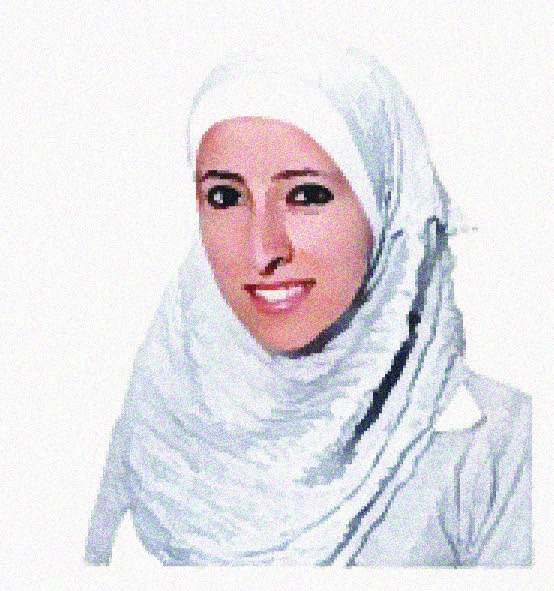 By Sura Alsamman
By Sura Alsamman
Sura Alsamman is nutrition supervisor at Save the Children Jordan, responsible for the overall all coordination of the IYCF technical functions and activities in camps and south of Jordan. Previously she worked in various maternal and child nutrition programmes.
Save the Children Jordan (SCJ) is a registered Jordanian NGO established in 1974, with Her Royal Highness, Princess Basma Bint Talal as the Chairperson of the Board. SCJ is part of and the only Arab member of the 30 Save the Children organisation members operating in 120 countries worldwide. In Jordan, SCJ develops much needed national programmes that focus on creating sustainable results where every child attains the right to survival, protection, development and participation.
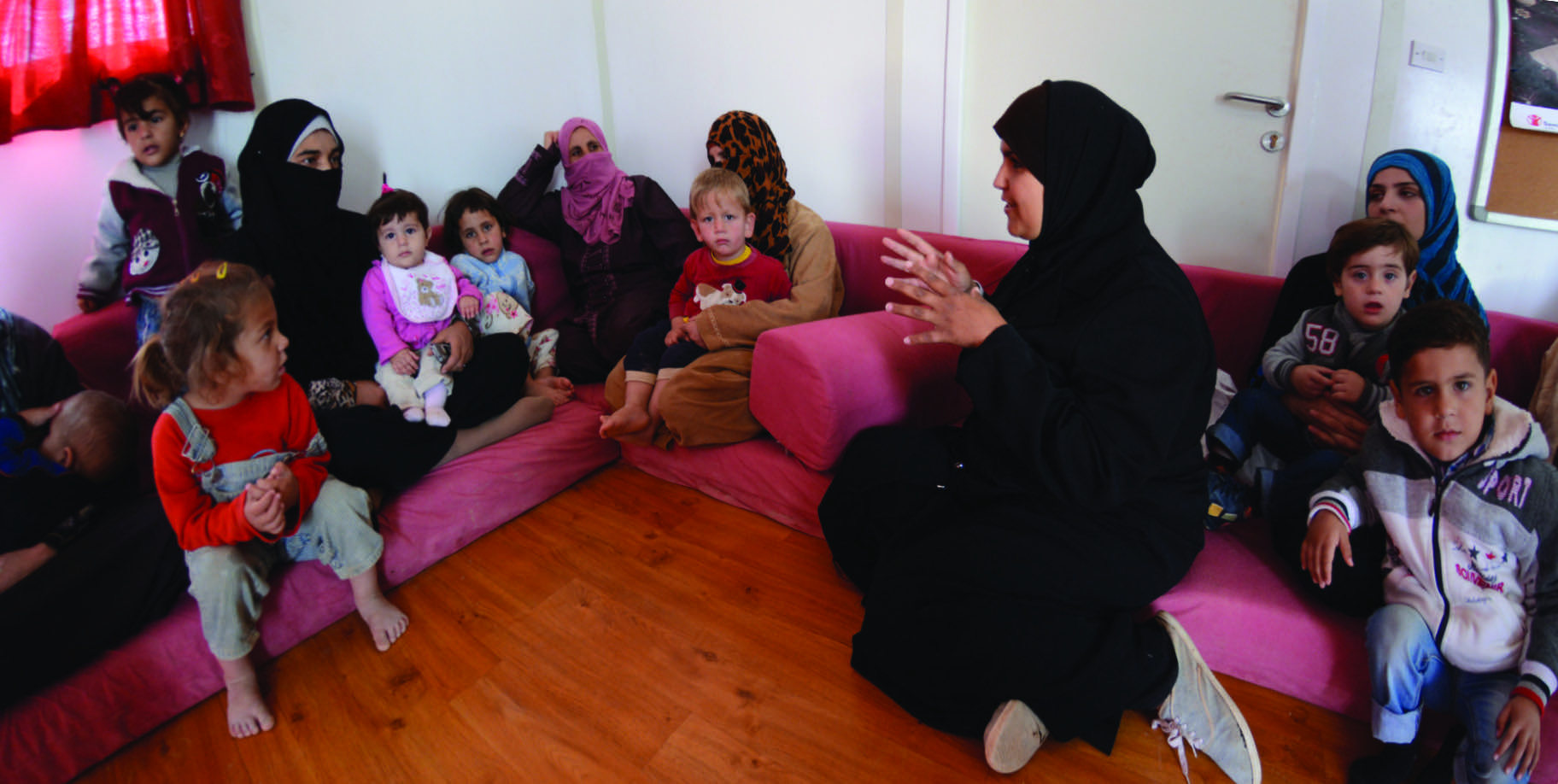 Since the beginning of the emergency in Syria, over 500,000 Syrians have crossed the borders into Jordan and are either hosted by the Jordanian community or residing in refugee camps. The first refugee camp in Jordan was Za’atari, administered by the Government of Jordan-appointed Syrian Refugee Camp Directorate (SRCD), with the support of UNHCR. More than 350,000 Syrians have been registered in Za’atari camp since its opening in July 2012. A large number of refugees have subsequently left Za’atari camp to urban and rural areas in Jordan.
Since the beginning of the emergency in Syria, over 500,000 Syrians have crossed the borders into Jordan and are either hosted by the Jordanian community or residing in refugee camps. The first refugee camp in Jordan was Za’atari, administered by the Government of Jordan-appointed Syrian Refugee Camp Directorate (SRCD), with the support of UNHCR. More than 350,000 Syrians have been registered in Za’atari camp since its opening in July 2012. A large number of refugees have subsequently left Za’atari camp to urban and rural areas in Jordan.
At the beginning of the emergency, a number of assessments were conducted to determine the health and nutrition needs of the refugees, including The Inter-Agency Nutrition Assessment conducted in November 20121. This recommended strengthening the awareness, promotion, and protection of optimal infant and young child feeding (IYCF) practices through preventive and nutrition promoting services.
Prior to the crisis, IYCF practices were already poor in Syria. According to the MICS2 survey of 2006, the prevalence of early initiation of breastfeeding was 46%, and the prevalence of exclusive breastfeeding in infants under 6 months of age was only 43%. IYCF indicators were not favourable in Jordan either; the 2012 DHS3 showed that in the past few years, exclusive breastfeeding rates have dropped from 27% to 23%. In Za’atari camp in Jordan, there was a high demand for infant formula early in the crisis response. Whilst only a small percentage of women requesting supplies were physiologically unable to breastfeed, common use of infant formula pre-crisis among the Syrian refugees, coupled with untargeted and unsolicited distribution of infant formula in the early humanitarian response and high levels of stress and anxiety among women, fuelled this demand.
In late 2012, a Nutrition sub-working group (Nutrition SWG) was established as a sub-group of the Health Working Group, initially chaired by UNHCR and co-chaired by Save the Children Jordan (SCJ) from November 2013. Initial advocacy and response initiatives involved the development and sharing of two key guiding documents through the Nutrition SWG, namely:
- Guidance Note on Appropriate Infant and Young Child Feeding Practices in the Current Refugee Emergency in Jordan (26th of November 2012)4.
- Standardised Operating Procedures (SOPs) on Donations, Distribution and Procurement of Infant Formula and Infant Feeding Equipment in the Current Refugee Emergency in Jordan (26th of November 2012)5.
Save the Children Jordan programme
Breastfeeding in an emergency is known to be the safest way to protect infants and young children from an increased risk of infection and from becoming malnourished. Breastfeeding support was a key recommendation of Inter-Agency Nutrition Assessment (as above). Given this, SCJ launched the Infant and Young Child Feeding in Emergencies (IYCF-E) programme in Za’atari camp in December 2012, after completing a technical training supported by Save the Children US. The programme was funded by OCHA, Save the Children US, UKAid and the German Cooperation-Save Germany. It aimed to reach 90% of pregnant and lactating women (PLWs) and children under 5 years in the camp. At the time (November 2012), the camp population was estimated to be 45,0006.
The programme’s main goal was to promote, protect, and support appropriate IYCF practices, including early initiation of breastfeeding within 1 hour of birth, exclusive breastfeeding for infants under 6 months, and appropriate and timely introduction of complementary food along with breastfeeding after 6 months.
Mother-baby friendly spaces
The IYCF programme started with the establishment of the first of three caravans serving as a mother-baby friendly space (safe haven). The caravan engaged a team of five trained IYCF counsellors responsible for individual counselling sessions and follow up, five educators responsible for group education sessions and 10 supporting Syrian community mobilisers.
A simple rapid assessment was conducted in the first few days of operation in Za’atari camp, to explore the prevailing infant feeding practices and challenges faced by PLWs and caregivers. This exercise allowed SCJ better to design the counselling and education sessions in the programme; it was not intended to provide a full dataset or statistical analysis. The assessment highlighted many misconceptions among mothers including mothers believing they don’t have enough breastmilk/mothers convinced that breastmilk is drying up due to stress/mothers believing that breastmilk is not enough for infants in the first few days of life. The rapid assessment indicated the need to emphasise the importance of exclusive breastfeeding and the correct timing of starting complementary feeding. The assessment also identified cases of breastfeeding difficulties, like engorgement and mastitis, which counsellors started following up onimmediately.
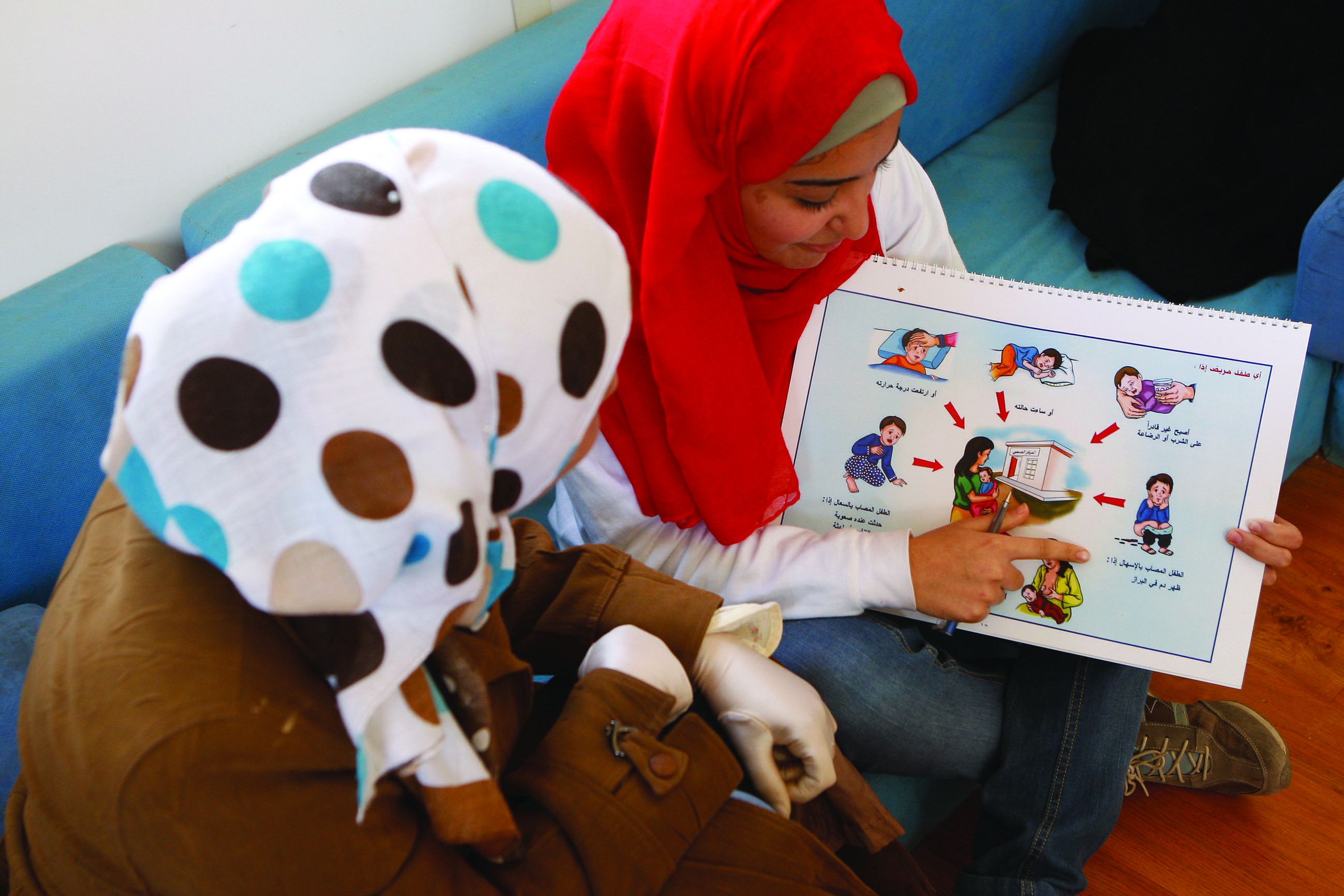 As the camp population rapidly increased, and in partnership with UNICEF, two new IYCF caravans were established to cover all 12 districts in the camp. Eight new staff members joined the team to support in following up with mothers. The IYCF caravans are located in districts 3, 4 and 8, next to the three main schools in the camp. Based on the camp population distribution, those caravans are reachable to most mothers. Each caravan currently has an educator and a Syrian caravan assistant on a daily basis, along with the counsellor and community mobiliser assigned for each district. On average, 120-150 mothers visit the three IYCF caravans on a daily basis. Some mothers attend daily, others weekly as they wish. On average, there are 150 new visits to the caravans per week.
As the camp population rapidly increased, and in partnership with UNICEF, two new IYCF caravans were established to cover all 12 districts in the camp. Eight new staff members joined the team to support in following up with mothers. The IYCF caravans are located in districts 3, 4 and 8, next to the three main schools in the camp. Based on the camp population distribution, those caravans are reachable to most mothers. Each caravan currently has an educator and a Syrian caravan assistant on a daily basis, along with the counsellor and community mobiliser assigned for each district. On average, 120-150 mothers visit the three IYCF caravans on a daily basis. Some mothers attend daily, others weekly as they wish. On average, there are 150 new visits to the caravans per week.
The caravan is promoted as a safe space for breastfeeding, where privacy and support is provided for all pregnant women and mothers with children under 5 years. Education sessions are held in the caravan on a daily basis from 9:00am till 3:00pm covering topics such as nutrition for PLW, the importance of breastfeeding, complementary feeding, and feeding during illness. Initially, infants who were using infant formula attended the paediatrician, but now are directed to the IYCF caravan also. A nutrient dense snack (high energy biscuit) and a bottle of water are provided to mothers as incentives to visit the caravan and to highlight the importance of nutrition and fluids for breastfeeding mothers. Breastfeeding shawls for privacy (provided by UNHCR as a gift in kind) were also distributed to lactating mothers. A bottle/cup amnesty activity also operates in the caravan, where mothers are encouraged to exchange any feeding bottle they have for a measured cup which is considered safer, more hygienic and easier to clean.
In order to respond to mothers concerns, IYCF educators follow up with the various health issues arising in the camp. For example, food safety and hygiene was emphasised when diarrhoea cases increased and the importance of early initiation of breastfeeding was emphasised when cases of jaundice were identified in newborns. In addition, the IYCF educators participate actively in the sensitisation and mobilisation for the different immunisation campaigns.
Over 18 months of operation (Dec 2012 to May 2014), the programme has reached 15,600 mothers through the caravan and tent counselling sessions in Za’atari camp. Non-breastfed infants are supported through individual counselling sessions. A high proportion of the mothers attend with children under 2 years of age.
Community mobilisers
From the early stages of implementation, community mobilisation was identified as one of the main components of the programme. It was agreed that each Jordanian staff (counsellor/educator) would closely work with a Syrian mobiliser who was chosen based on their background (nurses, college graduates) and how well they knew the camp community. The mobilisers main responsibilities are to identify mothers who need breastfeeding support and help in spreading the IYCF messages. If they encounter mothers using infant formula, they direct them to the IYCF caravans, or refer to a counsellor to investigate relactation, or at a minimum, ensure that are preparing infant formula as hygienically as possible. It is clear that having Syrian mothers as part of the team and communicating the same messages makes it much easier to communicate with the refugees and discuss their beliefs and misconceptions around infant feeding practices. Difficulty following up with mothers was one of the major challenges we faced at the beginning; families were constantly changing their locations in the camp (moving to a higher area, closer to the market, next to new arriving relatives). With no contact information other than the address given in the initial visit, it was very difficult to reach the mother again. However, with the help of the community mobilisers team and their connections with street leaders, the team were able to reach many of these cases. A case study regarding one community mobiliser’s experiences is included in Box 1.
Box 1: Community mobiliser – success story
Sara is one of the community mobilisers working with the IYCF team in Za’atari camp. Sara decided to join the team after her successful experience in breastfeeding her youngest child and seeing how this affected his health compared to his four older sisters.
Travelling with her four daughters, Sara arrived at the camp in the heat and dust of July 2012. As the days passed, Sara gradually settled in, amongst relatives and neighbours. She learned to cope in a difficult environment, with insufficient food supplies and inadequate accommodation conditions. Sara first visited us one cold December morning in 2012, as a result of an outreach campaign we conducted in the camp. She was pregnant with her fifth child. When she first came, she expressed her concern regarding sanitation in the camp and access to clean water. She did not possess sufficient knowledge about the benefits of breastfeeding her child. This applied to both her and the community as a whole.
With her delivery date approaching, the IYCF counsellors’ visits to Sara increased. She was taught the different positions for breastfeeding, the signs of proper breast attachment, the importance of colostrum (the first milk produced by a mother on giving birth), as it is rich in immunologically active cells, antibodies, Vitamin A and other protective proteins, and much more. After Sara’s discharge from the hospital on giving birth, IYCF counsellors from SCJ continued to visit her on a weekly basis to monitor the progress of the baby’s health and weight, provide emotional support for her, and answer any questions or address concerns she may have.
“For the first six months, I exclusively breastfed Tamer, as I had been advised; he is the only child I exclusively breastfed and I can clearly see the difference in comparison to his four older sisters. He is more resistant to diseases and infections, and is more alert and active. In addition, I myself experience great joy when I breastfeed him, I tend to transition into a state of serenity, tranquillity and bliss. A state that in a camp environment is unattainable.”
Even as Tamer grew, Sara continued to visit the IYCF caravan as often as possible. She would relate her story to other pregnant and lactating mothers and her enthusiasm was infectious. Sara has become our ambassador in Za’atari Camp. She is such a strong advocate of breastfeeding and so we are happy to have her among our team of Syrian camp mobilisers.
Coordination with partners and health facilities in the camp has also played a key role in disseminating IYCF messages. Through agreements and Memoranda of Understanding (MOUs) with different partners, IYCF educators have the opportunity to reach mothers and conduct sessions in clinics and women/youth centres. Recognising that contact with mothers immediately after birth increases the possibility of exclusive breastfeeding and early initiation, IYCF counsellors provide counselling sessions on a daily basis in the two health facilities providing delivery services in the camp.
Acknowledging the impact of the messages communicated by health providers, and noticing some cases of misinformation from health staff in the field clinics, it was crucial to ensure that unified IYCF messages were delivered by all doctors, midwives and nurses. Key information includes the importance of colostrum and early initiation of breastfeeding, duration of exclusive breastfeeding, timely introduction of complementary feeding, and indications for prescription of infant formula (medical indications and where infants are not breastfed, see below). To address these issues, an orientation session was conducted for all health providers on IYCF; key messages were also circulated through the health coordination meeting. Due to the high staff turnover in such situations, continuous follow up remains a necessity to ensure a unified message.
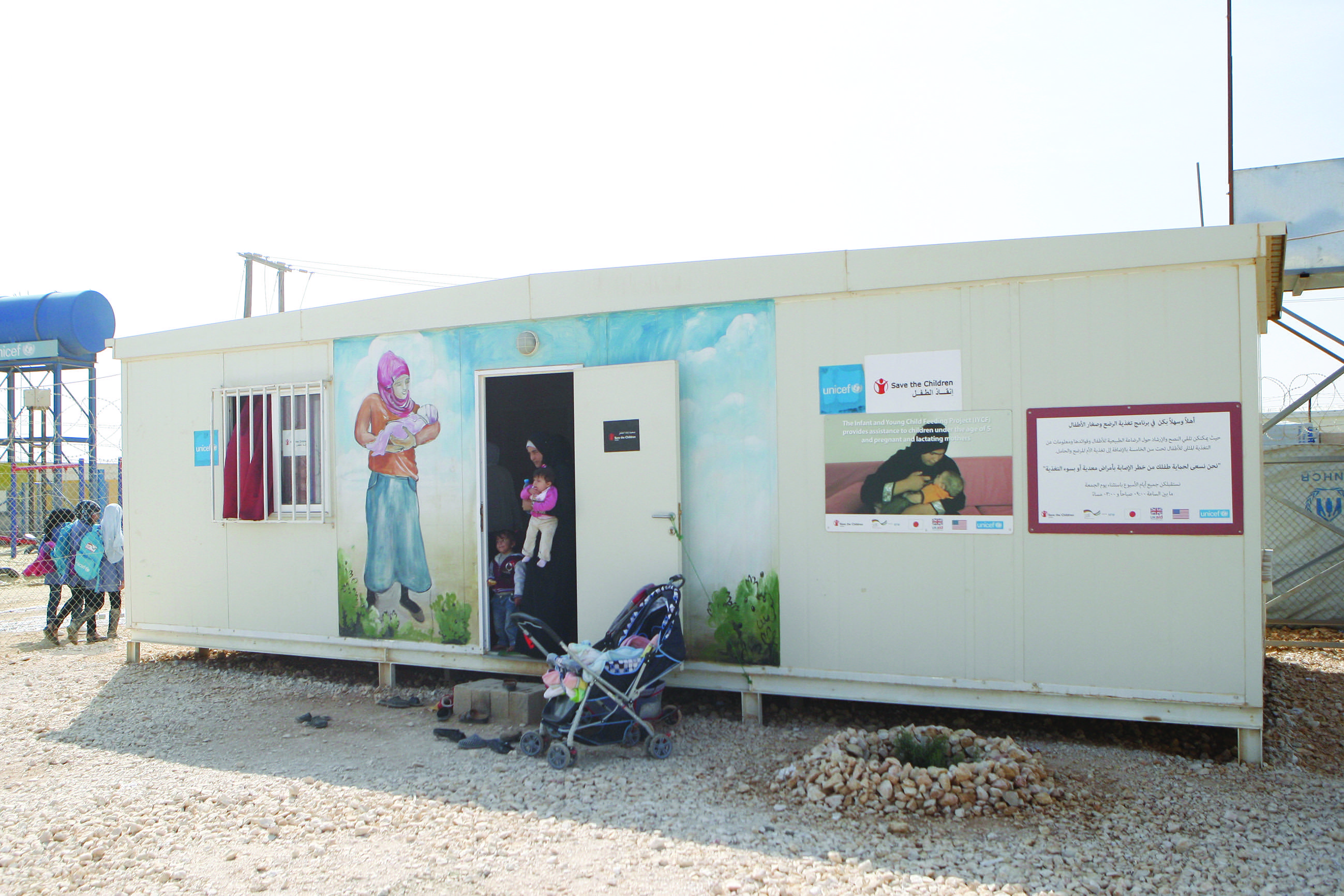 The difficulties in managing infant formula
The difficulties in managing infant formula
Monitoring infant formula prescription and dispensing has been a major challenge from the beginning of the crisis response in Jordan. Characteristics of optimal IYCF practices and the provisions of the International Code of Marketing of Breastmilk substitutes (BMS) were relatively unknown. Controlling BMS (typically infant formula) supply was a new concept among national health staff and caregivers, especially given that infant formula use was the norm for the Syrian community pre-crisis. Hence most of the caregivers argued it should be part of the ration or distributed for every family with children under 2 years of age. Field hospitals received donations of infant formula, bottles and teats and were distributing them for all mothers.
Infant formula prices are relatively high. Many mothers who received it opted to sell it in the camp streets or sent it outside to be sold in the community (it was clearly seen for sale in the camp market).To reduce distribution channels and ensure targeted distribution, UNHCR followed up on this issue. A series of meetings were held with different health providers to ensure that there was a system in place to manage the process of supply provision of infant formula. It was agreed that only one health facility would be responsible for dispensing infant formula and a protocol was established regarding individual assessment of need and supply method (see Box 1). It was very important for SCJ to make sure that IYCF caravans were not involved with any kind of BMS prescription or dispensing. Within a few days of starting the new process, however, it was clear that the refugees were not happy with it. Angry men would gather at the health facility and demand infant formula. In addition, they restrained their wives from taking the physical examinations. Many infant formula packs were taken by force and the midwife received several threats of attack.
Box 1: Individual level assessment for infant formula prescription
Infant formula is prescribed based on any of the medical indications for infant formula use as recommended by WHO7 or when physical examination of the mother finds there is no breastmilk supply.
All mothers requesting infant formula are required to undergo a physical examination by a midwife to determine if there is breastmilk supply. This includes mothers who have never breastfed. If the midwife determines that there is no breastmilk supply, the mother is prescribed infant formula. If the mother is found to be able to breastfeed based on physical examination and is found to have good milk supply, then she is not supplied with infant formula. In practice, in most cases where mothers are already using infant formula, there is not a ‘good’ supply of breastmilk, and these mothers are generally prescribed formula.
If the mother is interested in relactation, the counsellor follows up with her regularly and gradually decrease the quantity of infant formula provided. If the mother does not have breastmilk supply and is not interested in relactation, then she keeps visiting the midwife on a monthly basis to receive the infant formula prescription.
Infant formula is provided for infants until 12 months only.
Weighing infants on a monthly basis would be a useful additional indicator to inform and monitor infant formula prescription. Unfortunately growth monitoring is not yet in place, but its implementation is under discussion.
Sensitisation was critical for calming the situation. Mothers and caregivers were referred to the IYCF caravan for education sessions on the importance of controlling this prescription process and the dangers of artificial feeding in emergencies. IYCF educators were present on a daily basis in the health clinic explaining the importance of breastfeeding and superiority of breastmilk. But it was also clear that further security precautions needed to be in place. It was decided to have the prescription and dispensing in two different locations - the examination and prescription undertaken in the health clinic and the distribution at another more secure location. Once both locations were identified (this took some time), it was agreed that an IYCF staff member would be present in each facility to support and monitor the process. A database was developed to keep track of mothers receiving infant formula (names, ages, ration card number) to avoid duplication, to allow regular follow up to ensure hygienic and correct preparation of the infant formula and to explore the possibility of re-lactation. Even with the strict prescription criteria, infant formula tins were being sold in the camp market. Thus it was agreed with staff based in the dispensing site to open each tin once the mother received it. This mechanism worked well, as no one was then willing to buy an already opened tin of infant formula.
Infant formula donations and their untargeted distribution remain a challenge. Although the SOPs (see earlier) have been circulated, shared and discussed with all partners, individual donations of infant formula still find their way to the camp. It is worth noting that many mothers are refusing the donations or returning any quantities they receive as they are exclusively breastfeeding. Street leaders from the community approached the clinic a few months ago with quantities of donated formula; they wanted to leave it with the midwife as she would know who actually needs to receive it, which shows that the community is now aware of the risks of such distributions. An average of 10 new mothers is prescribed formula on a weekly basis. With the opening of a new refugee camp (Azraq camp) in Jordan in April 2014, many lessons have been applied from the experiences in Za’atari camp. A system for infant formula provision has been in place from the beginning. Upon prescription, mothers are given specific dates to go and receive the infant formula, the dispensing takes place twice a week, and a list is communicated each time from the prescription to the dispensing site to avoid any confusion. As of September 2014, 226 mothers are prescribed infant formula in Zaatari camp (camp population 79,708), 28 mothers in Asraq camp (approx. 13,000 population) and 7 mothers in Emarati Jordanian camp (EJC) (about 4000 population) (see below).
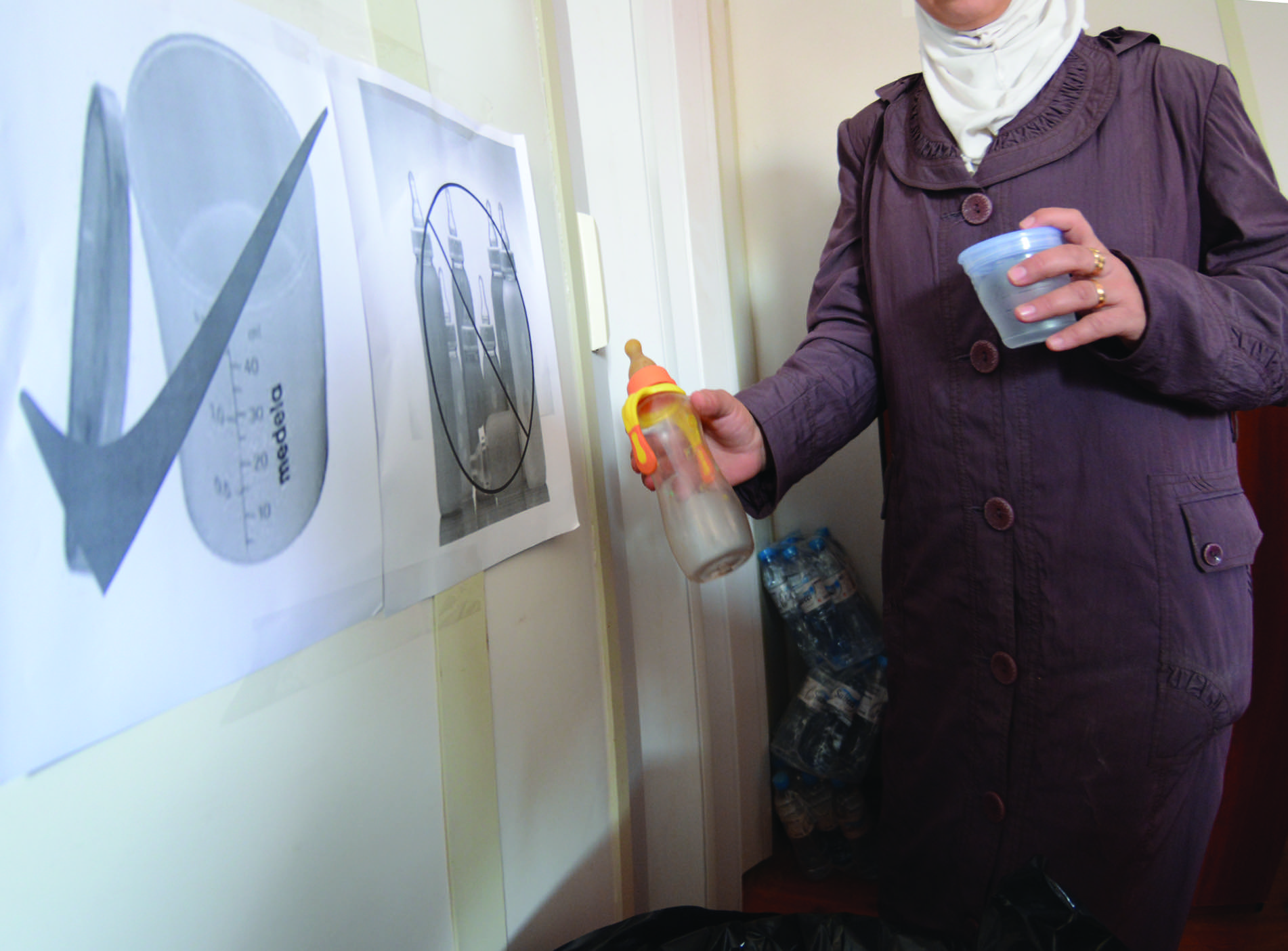 Complementary feeding
Complementary feeding
During the early days in Za’atri camp, the food ration was provided by WFP along with a complementary ration by UNHCR. People complained about lack of diversity, but the main concern from a nutritional point of view was meeting the needs of children aged 6-23 months. Mothers were constantly complaining that the ration didn’t include anything adequate for this age group, and not everyone in the camp had the ability to buy fruit and vegetables.
The need for a fortified food suitable for children 6-23 months was agreed and WFP sought procurement of international supply of Super Cereal Plus. Due to complications in procurement that delayed supplies by seven months (see below), UNHCR, UNICEF and SCJ stop-gapped with an intended short term (4 month) blanket distribution of a local fortified porridge, targeting children 6-23 months (March – June 2013). Four packs of 250g each were provided for each child on a monthly basis. Special cases, such as cerebral palsy children, were also included in the distribution. The distribution itself was a challenge as many security concerns were raised regarding families with older children who would not receive the product. Careful sensitisation was undertaken to inform the community and explain to them the importance and rationale of the product for this specific age group. The local complementary food was well received by families but was expensive. It was not available to purchase in the camp markets. Three cycles were completed but the fourth did not happen due to inadequate funds.
Referral and management of acute malnutrition cases
A mid upper arm circumference (MUAC) screening conducted by the SCJ team during the complementary food distribution period found a global acute malnutrition rate (GAM) rate of 2.6%. Since malnutrition was not a major concern in Jordan pre-crisis, there were no clear national protocols or referral pathways. The Nutrition SWG developed a national protocol, which was later adopted by the Ministry of Health, and drafted a letter requesting permission to import RUTF (Plumpy’nut) and fortified blended food (Super Cereal Plus). In reality, product approvals and releasing of the products from customs took more than six months. Thus the identified cases had to be managed using other interventions. Severe acute malnutrition (SAM) cases were referred to the MSF hospital inside the camp and moderate acute malnutrition (MAM) cases were provided with the locally procured fortified food porridge and followed up by IYCF counsellors. The local fortified food had a very good nutritional profile, and mothers were constantly instructed on preparation methods and number of meals to offer per day.
Eventually in January 2014, Super Cereal Plus was officially approved by the Jordan Food and Drug Administration (JFDA) and in partnership with WFP, SCJ launched the Supplementary Feeding Programme (SFP) in Za’atari camp. A blanket distribution for children 6-23 months is currently taking place on a monthly basis, and a targeted distribution with regular follow up is conducted for MAM cases twice a month. The Super Cereal Plus is not well accepted by the children compared to the local fortified porridge that was initially provided.
Outside Zaatri camp
As of July 2013, the SCJ IYCF programme was also providing services to the Emarati Jordanian camp (EJC) and to the host community. EJC is a relatively small camp compared to Za’atari with a population of only 3,600 refugees. The process of monitoring infant formula was also difficult at the beginning, as the clinic was providing infant formula on a weekly basis to all families with infants under 1 year of age. It took a while to convince the management and the health providers of the need to control this, and the adverse effect it could have on infant’s health. The IYCF midwife is now responsible for prescribing the infant formula and only seven mothers are now receiving supplies on medical grounds. Given the small camp population, SCJ is able to follow up with all infants under 1 year in the camp. Overall, 30-40 mothers receive IYCF counselling on a daily basis in the IYCF caravan. By working closely with the clinic, SCJ ensure that each infant below 6 months is being followed up by the IYCF counsellor in the camp.
Discussion
After 16 months of implementing IYCF in the camps and host community, we have successfully reached 29,000 PLW (new visits or first counselling contacts) and 40,000 children under 5 years (total contacts). More than 47,000 beneficiaries (mothers, fathers, and grandmothers) have attended the IYCF sessions conducted in different partner’s locations.
It is becoming clear that building capacity and cooperation with health providers on communicating a unified IYCF message plays a crucial role in convincing mothers of the importance of breastfeeding and early breastfeeding initiation. Higher rates of exclusive breastfeeding are noticed among mothers who are regularly followed up by IYCF counsellors, and anecdotally, many are noticing the lower incidence of diarrhoea and respiratory infections compared to other non-breastfed infants.
In terms of meeting the needs of infants dependent on infant formula, greater control on the implementation of the International Code of Marketing of BMS by the Ministry of Health would have been very helpful. Uncontrolled distribution of infant formula early in the crisis was a great cause of tension with the community; if the community had been informed of the procedures and guidelines from the beginning, we could have avoided many problems. This is what is currently being done in Azraq camp and there have been no problems. Now, in Za’atari camp, the needs of formula fed infants are being met - supplies are always available, there is a clear referral pathway and system in place for mothers who need formula and there is follow up of infants.
For more information, contact: Sura Alsamman, email: SAlsamman@savethechildren.org.jo
1 Inter-agency nutrition assessment Syrian refugees in Jordan host communities and Za-atari camp. Final report. January 2013
2 Multiple Indicator Cluster Survey (MICS), Syrian Arab Republic, 2006 http://www.childinfo.org/files/MICS3_Syria_FinalReport_2006_Eng.pdf?
3 Demographic and Health Surveys (DHS) for Jordan, 2012. http://dhsprogram.com/what-we-do/survey/survey-display-403.cfm?
4 Available at http://data.unhcr.org/syrianrefugees/regional.php?
5 Available at http://data.unhcr.org/syrianrefugees/regional.php?
6 Current estimates of Za’atari camp population are around 90,000 people (June 2014)
7 Acceptable medical reasons for use of breast-milk substitutes. WHO/NMH/NHD/09.01. WHO/FCH/CAH/09.01. http://www.who.int/maternal_child_adolescent/documents/WHO_FCH_CAH_09.01/en/?


